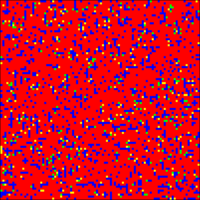Cooperation in structured populations
The tutorial on cooperation is divided into two parts: the first part, Cooperation in well-mixed populations, considers unstructured populations where every individual randomly interacts with any other member in the population. This simplifying assumptions allows to analytically determine the evolutionary outcome. This second part considers cooperation in structured population and, in particular, in spatially extended settings. In many cases this may be a more appropriate description of natural systems but it comes at the price that the dynamics is usually inaccessible to analytical investigations and relies on extensive simulation results.
In the simplest case, spatial structure can be implemented by placing an individual on each site of a regular lattices. The fitness of each individual is now determined from interactions within its neighborhood, which generally corresponds to a very limited subset of the population. Such limited interaction ranges, have surprisingly different effects on the evolution of cooperation based on the Prisoner's Dilemma or the Snowdrift Game. Extensions of the Prisoner's Dilemma to spatially structured populations have led to the general believe that spatial extension promotes cooperation. However, spatial structure fails to similarly favor cooperation under the less stringent conditions for cooperation as described by the Snowdrift Game (or Hawk-Dove game). In fact, in these games spatial structure actually tends to reduce the readiness to cooperate. Thus, our results caution against the established view that spatial structure is necessarily beneficial for cooperation.
This tutorial complements and illustrates a research article with Michael Doebeliin Nature (2004) 428 643-646.
Structured populations: pure strategies

In structured populations individuals are arranged on a lattice or network and interact only with their nearest neighbors. For pure strategies, where each individual is either a cooperator or defector, spatial structures promote cooperation in the Prisoner's Dilemma but fail to do so in the Snowdrift or Hawk-Dove game. In fact, this reduces cooperation as compared to well-mixed populations.
For deterministic update rules on the level of the individuals and synchronized updates of the population, fascinating spatio-temporal patterns may emerge from symmetrical initial configurations. The patterns resemble dynamical persian carpets or evolutionary kaleidoscopes and are observed for both the Snowdrift Game as well as the Prisoner's Dilemma.
Structured populations: mixed strategies

As above individuals are arranged on a lattice or network and interact only within a limited local neighborhood, but now each cooperates with a certain probability which leads to a continuous strategy space. In the Prisoner's Dilemma spatial structure is again beneficial for cooperation. However for the Snowdrift or Hawk-Dove game spatial structures promote cooperation only for asynchronous population updates while inhibiting it for synchronized updating.
Summary
The emergence of cooperative behavior in human and animal societies is one of the fundamental problems in biology and social sciences. Cooperation lead to major transitions in the history of life: molecules aggregated to protocells, genes arranged in chromosomes, cells shaped complex organisms or individuals formed societies - to name only a few. All examples have one thing in common: they are apparently at odds with Darwinian selection because they are prone to exploitation by cheaters that take advantage of the favorable conditions without contributing to it.
Over the last decades game theory - which describes strategic interactions between individuals - complemented by evolutionary principles - adding selection and reproduction - has become a powerful framework to investigate the problem of cooperation. A particulalry simple evolutionary game has attracted most attention: the Prisoner's Dilemma is a mathematical metaphor for situations where community and individual performance lead to a conflict of interest. One major theoretical result that was obtained from variations of the Prisoner's Dilemma setup states that any form of associative interactions favor cooperation. In particular, cooperation can thrive in the spatial Prisoner's Dilemma where individuals are confined to lattice sites and interact only within their local neighborhood.
Despite the considerable theoretical achievements the discomfort with the Prisoner's Dilemma as the sole paradigm to discuss cooperative behavior increased because of the considerable gap between theory and experimental evidence. In field and experimental studies it is often difficult to assess the payoffs in terms of fitness for the different behavioral patterns - even the proper ranking of the payoffs is challenging. Therefore, the stringent conditions of the Prioner's Dilemma may not be satisfied in many real natural situations. An interesting and biologically viable alternative is given by the Snowdrift game which equally refers to cooperative interactions but under relaxed conditions. In well-mixed populations with random encounters cooperators and defectors co-exist in a stable equilibrium which is stark contrast to the Prisoner's Dilemma where cooperators would go extinct.
In contrast to the spatial Prisoner's Dilemma, adding spatial structure to the Snowdrift game does not benefit cooperation. In fact, spatial structure tends to reduce cooperative behavior relative to well-mixed populations. In the spatial Prisoner's Dilemma cooperators can thrive by forming compact clusters such that losses of cooperators against defectors along the boundary are outweighed by gains from interactions within the cluster. However, this mechanism does not operate in the spatial Snowdrift game. Ironically the ultimate reason for this is the maintenance of cooperative behavior in well-mixed populations.
In behavioral ecology the Snowdrift game is better known as the Hawk-Dove game which models intraspecific competition - cooperation refers to sharing some resource while defectors escalate conflicts and attempt to monopolize the resource which bears the risk of injury when facing another defector. The two behavioral patterns can be adopted by one individual with certain probabilities and hence refers to mixed strategies. Results for well-mixed populations do not discriminate between pure and mixed strategies. Therefore, cooperative behavior is expected to occur with a certain non-zero probability. Adding spatial structure to the mixed strategy case of the Hawk-Dove game leads to another counter intuitive result: asynchronous population updates favors cooperation whereas synchronous updating increases defection. This contrasts with the established view that increased stochasticity should be detrimental to cooperation.
Therefore, our results for both, pure and mixed strategies, caution against the common belief that spatial structure favors cooperation and thus may not be as universally beneficial as previously believed.
References
This work was first published in
Hauert, Ch. & Doebeli, M. (2004) Spatial structure often inhibits the evolution of cooperation in the spatial Snowdrift game. Nature (2004) 428 643-646.
Press & News
- Cooperate with thy neighbour (2004) News & Views in Nature 428 by Taylor, P. D. & Day, T. (April 8).
- Generous Players (2004) ScienceNews 166 (4) 58-60 by Erika Klarreich (July 24)
- Warum einander helfen? (2004) NZZ (May 26)
This article 'Why help?' appeared in a national Swiss newspaper. - Selbstlose Helfer setzen sich durch (2004) Die Welt (April 14)
This article 'Altruistic individuals prevail' appeared in a national German newspaper. - Was hab' ich denn davon? (2004) wissenschaft-online (April 7).
This article 'What's in for me?' appeared on a German science portal.
Acknowledgements
For the development of these pages help and advice of the following two people was of particular importance: First, my thanks go to Michael Doebeli for helpful comments on the game theoretical parts and second, my thanks go to Urs Bill for introducing me into the Java language and for his patience and competence in answering my many technical questions. Financial support of the Swiss National Science Foundation is gratefully acknowledged.
